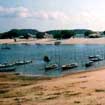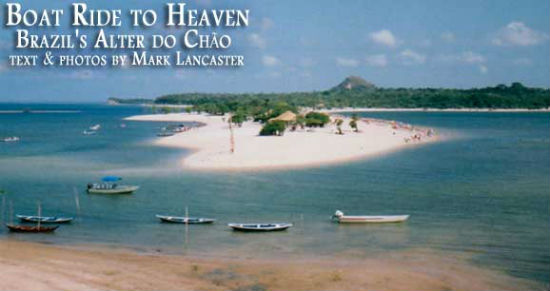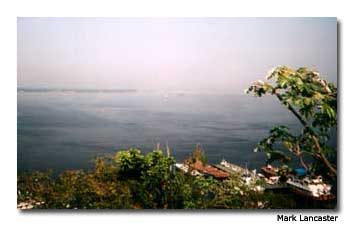

A strong scent of decay and fish fills my nostrils. The sounds of strangers speaking in rapid-fire Portuguese surround me, and the frenzy of market activity is all around. My heart races as I pick my way through the docks of Manaus, in the heart of the Amazon. I cannot find the office of SERPE, the agency that I hope will sell me a ticket to a destination downriver.My limited knowledge of Portuguese also handicaps me, so asking for directions is a dubious undertaking. But, having no choice, I attempt it anyway. Straining my language skills to the limit, I ask a man: “Onde é bilheteria para SERPE por favor?”Where is the SERPE ticket office please? I get a look of confusion and then an instant of comprehension. He points back to a set of stairs leading down to the river.
Within a few minutes I locate the office and book passage. My voyage will begin at 7 a.m. the next morning.
The boat leaves from a floating dock as the Amazon’s water level changes drastically from rainy to dry season. In the early morning light, the sun glints off the water, sparkling here and there as if revealing thousands of diamonds.
The wide expanse of the Amazon gently flows toward the Atlantic. Glancing to my left, I see a massive ocean liner appear as little more than a speck.
Looking to my right I see a large cargo vessel that appears to be the size of a child’s toy. The Amazon, the highway of Brazil and the world’s largest waterway by volume, is a river that dwarfs all others.
I am on a speedboat out of Manaus, headed toward the city of Santarém. The journey of nearly 400 kilometers (249 miles) takes 36 hours on a regular passenger boat, but with the speedboat it takes about 13 hours. I am on my way to Alter do Chão, “Altar of Heaven” in Portuguese, a beach resort southwest of Santarém on the shore of Rio Tapajós.
This Amazon village sits beneath two rolling green hills, one of which is shaped like a church altar, giving the area its name. Alter do Chão has a reputation of boasting one of the best beaches in Brazil.
A half-hour after departing Manaus, we encounter the curious sight of “the meeting of the waters.” Two distinctly different rivers — the “black” water of the Rio Negro and the “white” water of the Rio Solimões — merge just east of Manaus. The two rivers travel side by side for many kilometers before finally intermingling to become the Amazon.
The monotony of hours of jungle and river are broken by “botos,” river dolphins. Large pink humps break the surface without warning and quickly disappear.
The trip is smooth, as the river is placid. We make several stops at river towns to pick up passengers. Parintins, the town that hosts the lively Boi-Bumbá folklore festival every June, is among them. Night falls, and the lights of the city of Santarém finally come into view.
We are deposited at the docks. Finding a taxi, I take an approximately 30-mile (48 km) ride to my destination. The road — one of the few tarred thoroughfares in the municipality of Santarém — follows the Amazon at first, and then turns south at the tributary of the Rio Tapajós.
The ride is remarkably dark, as there are no streetlights. The town of Alter do Chão seems unremarkable at night. It is strung along the river with a few modest hotels and restaurants around a small square. I find a small room in a rustic but friendly hotel.
The next morning, after breakfast, I make my way to the shore. The breeze from the Rio Tapajós pleasantly caresses my face while the sun glares down. The scene has a Caribbean feel to it, with small boats on the beach and others with fixed sails plying the waters nearby.
Most of the year the bay is fringed by white sand beaches. Now, in the dry season, a sandbank in the middle of the bay is accessible either by wading or by small weathered canoes. Dozens of men are kept busy all day long making the two-minute voyage across at the cost of two Brazilian reals (US$ 1.15) each way.
Stepping onto the sandbank, I find that the sand has the consistency of talcum powder. The butter-colored sand in the heat of midday is hot to the touch. The island is an elongated oval that rises slightly in the center. Tents and shacks on the ridge of the sandbank sell fried fish, beer and soft drinks.
Along the shore, Brazilians enjoy Brahma beer as they rest and mingle under beach umbrellas. This is mostly a vacation area for the local middle class unless your visit unfortunately coincides with a shore excursion from a cruise ship docked at Santarém. The water lapping at my feet is dark, but clear, inviting me for a swim.

It has a warmth close to bath water. The play of shadow and light on the forest creates a patchwork quilt off in the distance. The whisper of the breeze in the treetops and quiet conversation mixes with the clinking of bottles.
Today I seem to be the only non-Brazilian out here. Absent too are the hawkers that are prominent on the beaches of Rio. Back on the beach I order a drink and a plateful of a local specialty — the ribs of the tambaqui fish, a relative of the Piranha and the largest member of the Characidae family. Tambaquis can reach a length of 3 feet (1 m). Hence I am given a massive portion. The flavor is delicate and slightly sweet. It is easily the best freshwater fish I have ever eaten.
Back in the village, the Center for the Preservation of Indian Art is one essential sight. The building, with painted adobe walls, houses an extensive collection of indigenous art from all over the Amazon Basin put together by an American and his Indian wife who settled here. A fair trade gift shop is attached.
Returning to my hotel later, I see the town come alive for the night. A cacophony of sounds from competing boom boxes and clubs fill the cool night air. It is Brazil’s independence day, and the president is addressing the nation on a nearby restaurant television.
He is completely ignored. This place is simply too laid back to care about politics. Many who come here change their plans and stay longer than they had anticipated. Unfortunately, I don’t have the option. I must leave after two days to catch my flight to Manaus, and then home.
Alter do Chão redefines the term “laid back.” For those seeking a place to worship the sun and leisure, this really is the “Altar of Heaven.”
If You Go
Brazil Tourism
www.braziltour.com
Mark Lancaster has traveled extensively in Latin America. A former truck driver, he is now in Nursing School. He lives with his wife and two of his four children in West Olive, Michigan.
